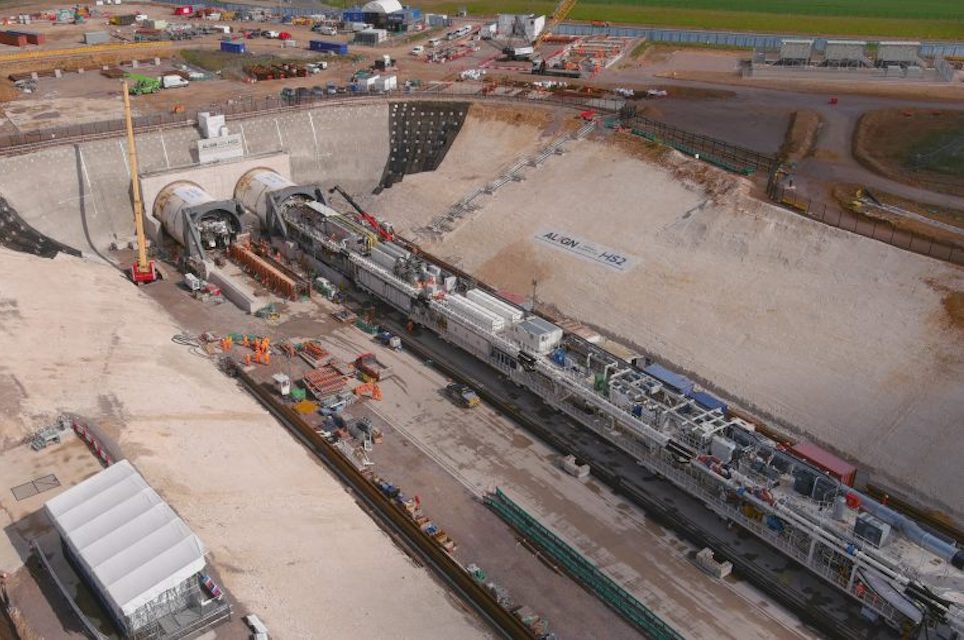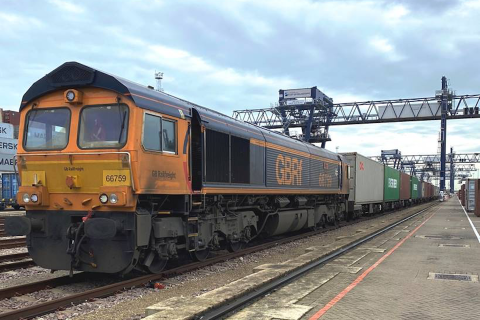All action at HS2 Willesden West London

High Speed 2 Limited, the company delivering Britain’s HS2 project, has had a busy, freight-related time at their West London logistics hub. With the company eager to promote its environmental, capacity and freight benefits, it has also been making itself family-friendly in a programme of recent events.
In the past week, the Willesden location has been host to an unveiling ceremony for what the company calls the ‘beating heart of HS2 in London’; and a naming ceremony for one of the many locomotives that will provide logistics support on the 30-acre site (12,15 hectares).
5,6million tonnes excavated
With 26-miles (42 kilometres) of tunnelling to be coordinated from the Willesden logistics hub, HS2 Limited is confident that rail freight operations will avoid something in the order of one million heavy truck movements. Rail freight will also help the company bring in construction materials, such as pre-cast tunnel segment rings. The hub has been constructed and will be operated by HS2’s Main Works Civils Contractor, Skanska Costain STRABAG joint venture (SCS JV).

The construction of HS2’s London tunnels will require 5,6 million tonnes of earth to be excavated. After being processed at the site near Willesden Junction, it will be taken by train to three locations across the UK – Barrington in Cambridgeshire, Cliffe in Kent, and Rugby in Warwickshire – where it will put to beneficial reuse, filling voids which will then be used as a basis for redevelopment, such as house building.
Materials by Rail programme
The site will also receive over 100,000 pre-cast tunnel segment rings, which will be used to form the walls of the London tunnels, delivered by rail from UK manufacturing sites. HS2’s contractor SCS JV has already confirmed that the first contract for pre-cast tunnel segment rings has been awarded to Pacadar UK and will be delivered to the site from their factory in the Isle of Grain in Kent.
At peak operation, eight trains per day will depart and arrive at the logistics hub, maximising the use of rail freight in the construction of HS2 in London and resulting in one million lorry movements not going on UK roads. “In building Britain’s new high-speed railway, HS2 is committed to protecting the environment and minimising our carbon footprint during design, construction and operation”, said HS2’s Chief Executive Officer, Mark Thurston, speaking at the official opening of the Logistics Hub. “As a result, we are moving as much material as we can by rail as part of our Materials by Rail programme. The logistics hub at Willesden will be the beating heart of our London logistics operation and is a critical part of how we are building HS2.”
Bespoke software monitors the logistics hub
The operation is being coordinated from a refurbished building on the site. Sheffield based rail technology specialists 3Squared, have developed a bespoke logistics software solution to manage and track the railway materials movements in and out.
“It is fantastic to see the hard work and effort coming to fruition in this large-scale logistics operation, which will radically improve efficiencies and operations across the wider UK transport network”, said Tim Jones, Managing Director of 3Squared. “Joining the HS2 project has marked an exciting chapter in 3Squared’s journey, and we look forward to continuing to work with SCS JV and providing our technological skill and expertise as HS2 progresses.”
The Green Progressor
Adding a lighter note to the week, a teenage rail fan, Jermaine Allen from Leeds, unveiled a nameplate for GB Railfreight engine 66796, “The Green Progressor”. The locomotive features a brand-new livery, promoting the environmental benefits of delivering construction materials by rail, which inspired the name that Jermaine had chosen.
Accompanied by his parents, Jermaine has visited several construction sites along the 140-mile route that HS2 will follow between the West Midlands and London Euston, learning about the construction methods HS2 is adopting in readiness for the arrival of Britain’s high-speed railway providing low carbon transport. Ironically, leaked reports in the last two weeks have cast serious doubt on the prospect of HS2 ever reaching Jermaine’s home town.
More capacity from old facilities
66796 is one of five Class 66 locomotives imported from Germany by GB Railfreight to provide more capacity for Britain’s growing rail freight sector. It is scheduled to make its maiden journey by the end of the year; once refurbishment works, that will see the locomotive fitted with the latest communications systems are completed.
The London Logistics Hub sits on the old Freightliner Terminal (the intermodal operations of the former nationalised British Railways) site opened in 1967. It became one of nine regional freight terminals developed specifically to handle Channel Tunnel intermodal traffic but eventually went into disuse in 2005.
You just read one of our premium articles free of charge
Want full access? Take advantage of our exclusive offer




